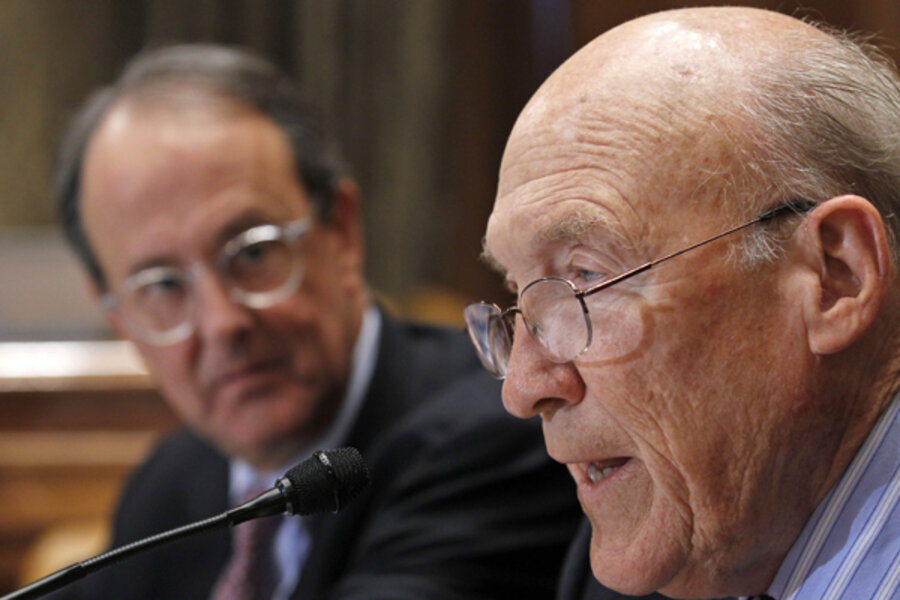Why the Simpson-Bowles budget defeat isn't the end of the line
Loading...
A budget plan based on the 2010 Simpson-Bowles proposal for cutting the nation’s debt and deficit was put to its first-ever vote in Congress Wednesday night after 14 months of languishing as something between a policy paper and a bipartisan pipe dream.
It went down in flames.
The proposal, built from the work of a bipartisan commission established by President Obama to determine the best approach to America’s long-term financial challenges, was defeated 38 to 382. The plan attempts to cut the US deficit by $4 trillion over the next decade through a mix of spending cuts and higher taxes.
Still, the lopsided vote count may obscure the proposal’s potential to impact the debt debate.
“In order to achieve a big and balanced deficit-reduction package, we must build a broad consensus," said House Democratic whip Steny Hoyer of Maryland, in a statement. "The budget ... came to the floor before that broad consensus could be achieved, which is why I voted against it.”
“I continue to believe that the Bowles-Simpson model should be a basis for ongoing discussions in the effort to create the needed consensus," he added.
How could a plan that was so thoroughly creamed stay relevant? With a likely spending showdown looming in December, the plan's bipartisan bona fides make it worth pursuing, said Reps. Steven LaTourette (R) of Ohio and Jim Cooper (D) of Tennessee, the bill's sponsors, on the House floor and in interviews before the vote Wednesday.
Of the six other budget proposals before the House, ranging from plans by the arch-conservative Republican Study Committee to the Congressional Black Caucus, “there’s only one that’s bipartisan,” said Representative Cooper.
That fact is going to be important come December, when Congress will have to deal with a slew of critical financial issues, including the extension of the Bush tax cuts, the start of the spending-slashing sequester, the expiration of the payroll tax holiday, and another needed increase in the nation’s debt ceiling.
Given that the GOP budget offered by House Budget Chairman Paul Ryan (R) of Wisconsin, slated to pass on Thursday, is a political nonstarter in the Democratic-controlled Senate – and that House Republicans will beat back all Democratic proposals – the Bowles-Simpson plan will give the nation a bipartisan blueprint for how to proceed when the chips are down, say LaTourette and Cooper.
“It’s where we’re going to be in December, so we might as well begin the conversation now,” LaTourette said.
For now, however, those projections don’t lessen the sting of what was a resounding drubbing.
LaTourette had predicted that the bill could garner as many as 100 votes. That would match the number of lawmakers who signed a letter last summer urging the budget "super committee," a lawmaker panel created to find $1.2 trillion in savings as part of an accord that allowed Mr. Obama to raise the debt ceiling earlier this year, to “go big” and find more than the minimum level of savings.
But on Wednesday, only 16 House Republicans and 22 Democrats backed the measure.
Several factors worked against a bigger, bipartisan vote. First, LaTourette and Cooper unveiled their proposal on Tuesday, before seeing the vote on their bill moved up, along with five other budget proposals, from Thursday morning to Wednesday night. This left them hustling to rally support for the plan.
Second, key interest groups on both sides gave the measure a thumbs down in the hours before the vote. Among them were the AFL-CIO, the largest American union, on the left and Americans for Tax Reform, the leading antitax group, on the right.
Finally, wavering lawmakers may have been given further pause after the “nays” rocketed north of 200 as the “yea” votes struggled to top 20 soon after the voting began after 9 p.m. on Wednesday.
“We have been viciously attacked from the left and the right, and when you know you have a good deal is when the left and the right are pounding the snot out of you,” LaTourette said on the House floor.
But he had a challenge for his colleagues as well. Later, he added: “If not now, when? And if not this, what?”





